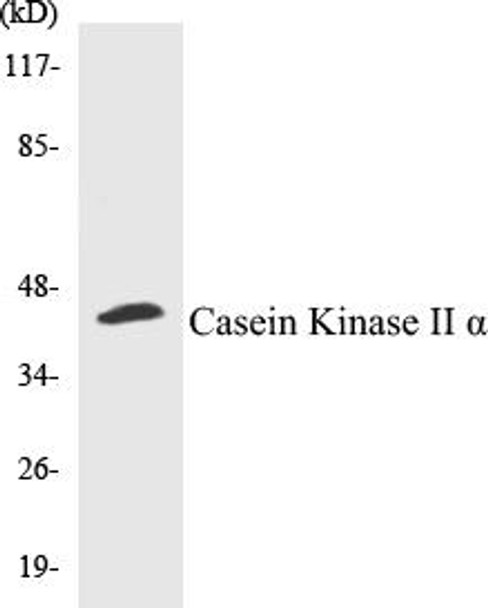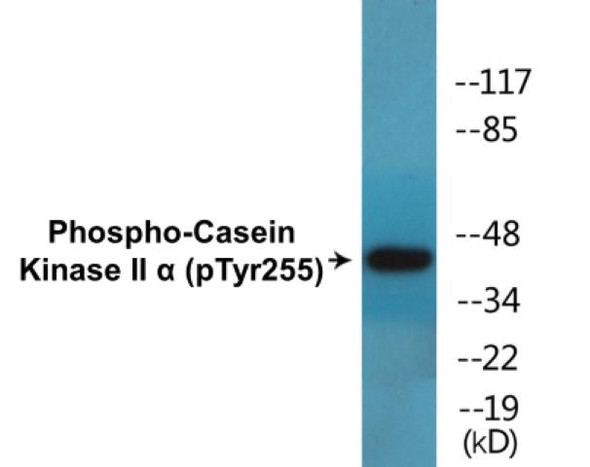Description
Casein Kinase II alpha Colorimetric Cell-Based ELISA Kit
The Casein Kinase II Alpha Colorimetric Cell-Based ELISA Kit from Assaygenie is a cutting-edge tool for the precise measurement of Casein Kinase II Alpha levels in cell lysates and tissue homogenates. This kit offers exceptional sensitivity and specificity, enabling researchers to obtain accurate and consistent results for their studies.Casein Kinase II Alpha is a key regulatory enzyme involved in various cellular processes, including cell cycle regulation, gene expression, and signal transduction. Dysregulation of Casein Kinase II Alpha has been implicated in various diseases, such as cancer, neurodegenerative disorders, and inflammation, making it a valuable target for drug discovery and therapeutic interventions.
With the Assaygenie Casein Kinase II Alpha Colorimetric Cell-Based ELISA Kit, researchers can gain valuable insights into the role of this enzyme in disease development and progression, paving the way for the development of novel treatment strategies. Trust Assaygenie for high-quality research tools that deliver reliable and consistent results.
| Product Name: | Casein Kinase II alpha Colorimetric Cell-Based ELISA |
| Product Code: | CBCAB00279 |
| ELISA Type: | Cell-Based |
| Target: | Casein Kinase II alpha |
| Reactivity: | Human, Mouse, Rat |
| Dynamic Range: | > 5000 Cells |
| Detection Method: | Colorimetric 450 nmStorage/Stability:4°C/6 Months |
| Format: | 96-Well Microplate |
The Casein Kinase II alpha Colorimetric Cell-Based ELISA Kit is a convenient, lysate-free, high throughput and sensitive assay kit that can detect Casein Kinase II alpha protein expression profile in cells. The kit can be used for measuring the relative amounts of Casein Kinase II alpha in cultured cells as well as screening for the effects that various treatments, inhibitors (ie siRNA or chemicals), or activators have on Casein Kinase II alpha.
Qualitative determination of Casein Kinase II alpha concentration is achieved by an indirect ELISA format. In essence, Casein Kinase II alpha is captured by Casein Kinase II alpha-specific primary antibodies while the HRP-conjugated secondary antibodies bind the Fc region of the primary antibody. Through this binding, the HRP enzyme conjugated to the secondary antibody can catalyze a colorimetric reaction upon substrate addition. Due to the qualitative nature of the Cell-Based ELISA, multiple normalization methods are needed:
| 1. | A monoclonal antibody specific for human GAPDH is included to serve as an internal positive control in normalizing the target absorbance values. |
| 2. | Following the colorimetric measurement of HRP activity via substrate addition, the Crystal Violet whole-cell staining method may be used to determine cell density. After staining, the results can be analysed by normalizing the absorbance values to cell amounts, by which the plating difference can be adjusted. |
| Database Information: | Gene ID: 1457, UniProt ID: P68400, OMIM: 115440, Unigene: Hs.644056/Hs.654675 |
| Gene Symbol: | CSNK2A1 |
| Sub Type: | None |
| UniProt Protein Function: | CK2A1: an ubiquitous protein kinase of the CK2 family. Exists as a tetramer composed of two catalytic subunits, alpha and alpha-prime, and two regulatory beta subunits. The beta subunits undergo autophosphorylation. The isoforms are rarely specified in publications. Two splice variant isoforms have been found. Participates in Wnt signaling. Phosphorylates E2 ubiquitin conjugating enzyme UBC3B inducing its interaction with beta-TRCp and enhancing beta-catenin degradation. May control IkB-alpha and p27Kip1 degradation. component of a CK2-SPT16-SSRP1 complex composed of SSRP1, PT16 CK2-A1, CK2-A2 and CK2-B the complex associating following UV irradiation. Interacts with RNPS1. Mouse transgene causes mammary gland hyperplasia and lymphoma, and activation by bovine parasites leads to fatal lymphoproliferation. Expression and activity are elevated in lung tumors and breast tumors. Antisense drives apoptosis of tumor cell lines and xenografts. Involved in DNA break repair by phosphorylation of scaffold protein XRCC1, phosphorylation of BRCA1, and phosphorylation of p53 in response to UV irradiation. Drosophila CK2 (Timekeeper) is involved in circadian regulation. Phosphorylates and binds to a major component of the inclusion bodies seen in Parkinson?s patients. Inhibitors: 4,5,6,7-tetrabromobenzotriazole (TBB). |
| UniProt Protein Details: | Protein type:EC 2.7.11.1; Kinase, protein; Protein kinase, Ser/Thr (non-receptor); Protein kinase, Other; Other group; CK2 family Chromosomal Location of Human Ortholog: 20p13 Cellular Component: Sin3 complex; plasma membrane; PcG protein complex; NuRD complex; cytosol; nucleus Molecular Function:protein serine/threonine kinase activity; protein binding; protein N-terminus binding; Hsp90 protein binding; ATP binding Biological Process: axon guidance; Wnt receptor signaling pathway; transcription, DNA-dependent; rhythmic process; negative regulation of caspase activity; signal transduction; positive regulation of cell growth; protein amino acid phosphorylation; regulation of transcription, DNA-dependent; positive regulation of cell proliferation; positive regulation of protein catabolic process; mitotic cell cycle; positive regulation of Wnt receptor signaling pathway |
| NCBI Summary: | Casein kinase II is a serine/threonine protein kinase that phosphorylates acidic proteins such as casein. It is involved in various cellular processes, including cell cycle control, apoptosis, and circadian rhythm. The kinase exists as a tetramer and is composed of an alpha, an alpha-prime, and two beta subunits. The alpha subunits contain the catalytic activity while the beta subunits undergo autophosphorylation. The protein encoded by this gene represents the alpha subunit. While this gene is found on chromosome 20, a related transcribed pseudogene is found on chromosome 11. Three transcript variants encoding two different proteins have been found for this gene. [provided by RefSeq, Jul 2014] |
| UniProt Code: | P68400 |
| NCBI GenInfo Identifier: | 55977123 |
| NCBI Gene ID: | 1457 |
| NCBI Accession: | P68400.1 |
| UniProt Secondary Accession: | P68400,P19138, P20426, Q14013, Q5U065, B4DYS6, D3DVV8 |
| UniProt Related Accession: | P68400,Q8NEV1 |
| Molecular Weight: | 391 |
| NCBI Full Name: | Casein kinase II subunit alpha |
| NCBI Synonym Full Names: | casein kinase 2, alpha 1 polypeptide |
| NCBI Official Symbol: | CSNK2A1 |
| NCBI Official Synonym Symbols: | CKII; CK2A1; CSNK2A3 |
| NCBI Protein Information: | casein kinase II subunit alpha; CK II alpha 3; protein kinase CK2; CK2 catalytic subunit alpha; casein kinase II alpha 1 subunit; casein kinase II alpha 1 polypeptide pseudogene |
| UniProt Protein Name: | Casein kinase II subunit alpha |
| Protein Family: | Casein kinase |
| UniProt Gene Name: | CSNK2A1 |
| UniProt Entry Name: | CSK21_HUMAN |
| Component | Quantity |
| 96-Well Cell Culture Clear-Bottom Microplate | 2 plates |
| 10X TBS | 24 mL |
| Quenching Buffer | 24 mL |
| Blocking Buffer | 50 mL |
| 15X Wash Buffer | 50 mL |
| Primary Antibody Diluent | 12 mL |
| 100x Anti-Phospho Target Antibody | 60 µL |
| 100x Anti-Target Antibody | 60 µL |
| Anti-GAPDH Antibody | 60 µL |
| HRP-Conjugated Anti-Rabbit IgG Antibody | 12 mL |
| HRP-Conjugated Anti-Mouse IgG Antibody | 12 mL |
| SDS Solution | 12 mL |
| Stop Solution | 24 mL |
| Ready-to-Use Substrate | 12 mL |
| Crystal Violet Solution | 12 mL |
| Adhesive Plate Seals | 2 seals |
The following materials and/or equipment are NOT provided in this kit but are necessary to successfully conduct the experiment:
- Microplate reader able to measure absorbance at 450 nm and/or 595 nm for Crystal Violet Cell Staining (Optional)
- Micropipettes with capability of measuring volumes ranging from 1 µL to 1 ml
- 37% formaldehyde (Sigma Cat# F-8775) or formaldehyde from other sources
- Squirt bottle, manifold dispenser, multichannel pipette reservoir or automated microplate washer
- Graph paper or computer software capable of generating or displaying logarithmic functions
- Absorbent papers or vacuum aspirator
- Test tubes or microfuge tubes capable of storing ≥1 ml
- Poly-L-Lysine (Sigma Cat# P4832 for suspension cells)
- Orbital shaker (optional)
- Deionized or sterile water
*Note: Protocols are specific to each batch/lot. For the correct instructions please follow the protocol included in your kit.
| Step | Procedure |
| 1. | Seed 200 µL of 20,000 adherent cells in culture medium in each well of a 96-well plate. The plates included in the kit are sterile and treated for cell culture. For suspension cells and loosely attached cells, coat the plates with 100 µL of 10 µg/ml Poly-L-Lysine (not included) to each well of a 96-well plate for 30 minutes at 37°C prior to adding cells. |
| 2. | Incubate the cells for overnight at 37°C, 5% CO2. |
| 3. | Treat the cells as desired. |
| 4. | Remove the cell culture medium and rinse with 200 µL of 1x TBS, twice. |
| 5. | Fix the cells by incubating with 100 µL of Fixing Solution for 20 minutes at room temperature. The 4% formaldehyde is used for adherent cells and 8% formaldehyde is used for suspension cells and loosely attached cells. |
| 6. | Remove the Fixing Solution and wash the plate 3 times with 200 µL 1x Wash Buffer for five minutes each time with gentle shaking on the orbital shaker. The plate can be stored at 4°C for a week. |
| 7. | Add 100 µL of Quenching Buffer and incubate for 20 minutes at room temperature. |
| 8. | Wash the plate 3 times with 1x Wash Buffer for 5 minutes each time. |
| 9. | Add 200 µL of Blocking Buffer and incubate for 1 hour at room temperature. |
| 10. | Wash 3 times with 200 µL of 1x Wash Buffer for 5 minutes each time. |
| 11. | Add 50 µL of 1x primary antibodies (Anti-Casein Kinase II alpha Antibody and/or Anti-GAPDH Antibody) to the corresponding wells, cover with Parafilm and incubate for 16 hours (overnight) at 4°C. If the target expression is known to be high, incubate for 2 hours at room temperature. |
| 12. | Wash 3 times with 200 µL of 1x Wash Buffer for 5 minutes each time. |
| 13. | Add 50 µL of 1x secondary antibodies (HRP-Conjugated AntiRabbit IgG Antibody or HRP-Conjugated Anti-Mouse IgG Antibody) to corresponding wells and incubate for 1.5 hours at room temperature. |
| 14. | Wash 3 times with 200 µL of 1x Wash Buffer for 5 minutes each time. |
| 15. | Add 50 µL of Ready-to-Use Substrate to each well and incubate for 30 minutes at room temperature in the dark. |
| 16. | Add 50 µL of Stop Solution to each well and read OD at 450 nm immediately using the microplate reader. |
(Additional Crystal Violet staining may be performed if desired – details of this may be found in the kit technical manual.)






